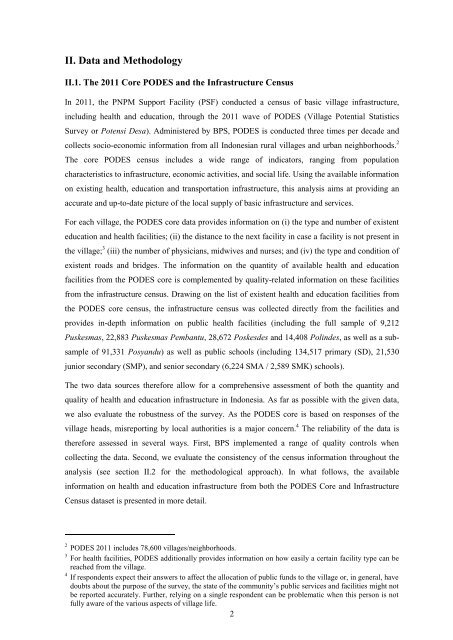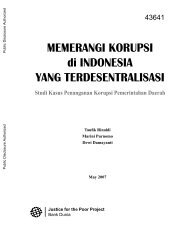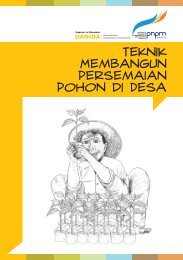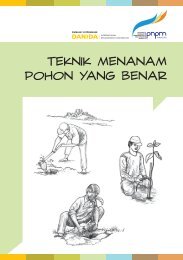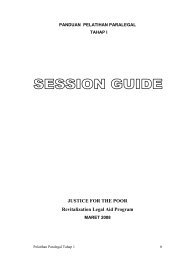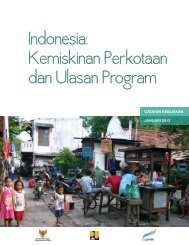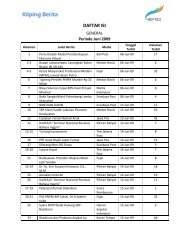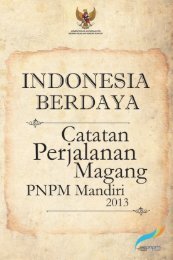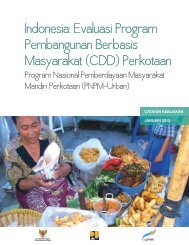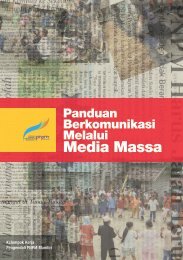PODES Infrastructure Census 2011 Report on ... - psflibrary.org
PODES Infrastructure Census 2011 Report on ... - psflibrary.org
PODES Infrastructure Census 2011 Report on ... - psflibrary.org
You also want an ePaper? Increase the reach of your titles
YUMPU automatically turns print PDFs into web optimized ePapers that Google loves.
II. Data and MethodologyII.1. The <str<strong>on</strong>g>2011</str<strong>on</strong>g> Core <str<strong>on</strong>g>PODES</str<strong>on</strong>g> and the <str<strong>on</strong>g>Infrastructure</str<strong>on</strong>g> <str<strong>on</strong>g>Census</str<strong>on</strong>g>In <str<strong>on</strong>g>2011</str<strong>on</strong>g>, the PNPM Support Facility (PSF) c<strong>on</strong>ducted a census of basic village infrastructure,including health and educati<strong>on</strong>, through the <str<strong>on</strong>g>2011</str<strong>on</strong>g> wave of <str<strong>on</strong>g>PODES</str<strong>on</strong>g> (Village Potential StatisticsSurvey or Potensi Desa). Administered by BPS, <str<strong>on</strong>g>PODES</str<strong>on</strong>g> is c<strong>on</strong>ducted three times per decade andcollects socio-ec<strong>on</strong>omic informati<strong>on</strong> from all Ind<strong>on</strong>esian rural villages and urban neighborhoods. 2The core <str<strong>on</strong>g>PODES</str<strong>on</strong>g> census includes a wide range of indicators, ranging from populati<strong>on</strong>characteristics to infrastructure, ec<strong>on</strong>omic activities, and social life. Using the available informati<strong>on</strong><strong>on</strong> existing health, educati<strong>on</strong> and transportati<strong>on</strong> infrastructure, this analysis aims at providing anaccurate and up-to-date picture of the local supply of basic infrastructure and services.For each village, the <str<strong>on</strong>g>PODES</str<strong>on</strong>g> core data provides informati<strong>on</strong> <strong>on</strong> (i) the type and number of existenteducati<strong>on</strong> and health facilities; (ii) the distance to the next facility in case a facility is not present inthe village; 3 (iii) the number of physicians, midwives and nurses; and (iv) the type and c<strong>on</strong>diti<strong>on</strong> ofexistent roads and bridges. The informati<strong>on</strong> <strong>on</strong> the quantity of available health and educati<strong>on</strong>facilities from the <str<strong>on</strong>g>PODES</str<strong>on</strong>g> core is complemented by quality-related informati<strong>on</strong> <strong>on</strong> these facilitiesfrom the infrastructure census. Drawing <strong>on</strong> the list of existent health and educati<strong>on</strong> facilities fromthe <str<strong>on</strong>g>PODES</str<strong>on</strong>g> core census, the infrastructure census was collected directly from the facilities andprovides in-depth informati<strong>on</strong> <strong>on</strong> public health facilities (including the full sample of 9,212Puskesmas, 22,883 Puskesmas Pembantu, 28,672 Poskesdes and 14,408 Polindes, as well as a subsampleof 91,331 Posyandu) as well as public schools (including 134,517 primary (SD), 21,530junior sec<strong>on</strong>dary (SMP), and senior sec<strong>on</strong>dary (6,224 SMA / 2,589 SMK) schools).The two data sources therefore allow for a comprehensive assessment of both the quantity andquality of health and educati<strong>on</strong> infrastructure in Ind<strong>on</strong>esia. As far as possible with the given data,we also evaluate the robustness of the survey. As the <str<strong>on</strong>g>PODES</str<strong>on</strong>g> core is based <strong>on</strong> resp<strong>on</strong>ses of thevillage heads, misreporting by local authorities is a major c<strong>on</strong>cern. 4 The reliability of the data istherefore assessed in several ways. First, BPS implemented a range of quality c<strong>on</strong>trols whencollecting the data. Sec<strong>on</strong>d, we evaluate the c<strong>on</strong>sistency of the census informati<strong>on</strong> throughout theanalysis (see secti<strong>on</strong> II.2 for the methodological approach). In what follows, the availableinformati<strong>on</strong> <strong>on</strong> health and educati<strong>on</strong> infrastructure from both the <str<strong>on</strong>g>PODES</str<strong>on</strong>g> Core and <str<strong>on</strong>g>Infrastructure</str<strong>on</strong>g><str<strong>on</strong>g>Census</str<strong>on</strong>g> dataset is presented in more detail.2 <str<strong>on</strong>g>PODES</str<strong>on</strong>g> <str<strong>on</strong>g>2011</str<strong>on</strong>g> includes 78,600 villages/neighborhoods.3 For health facilities, <str<strong>on</strong>g>PODES</str<strong>on</strong>g> additi<strong>on</strong>ally provides informati<strong>on</strong> <strong>on</strong> how easily a certain facility type can bereached from the village.4 If resp<strong>on</strong>dents expect their answers to affect the allocati<strong>on</strong> of public funds to the village or, in general, havedoubts about the purpose of the survey, the state of the community’s public services and facilities might notbe reported accurately. Further, relying <strong>on</strong> a single resp<strong>on</strong>dent can be problematic when this pers<strong>on</strong> is notfully aware of the various aspects of village life.2


